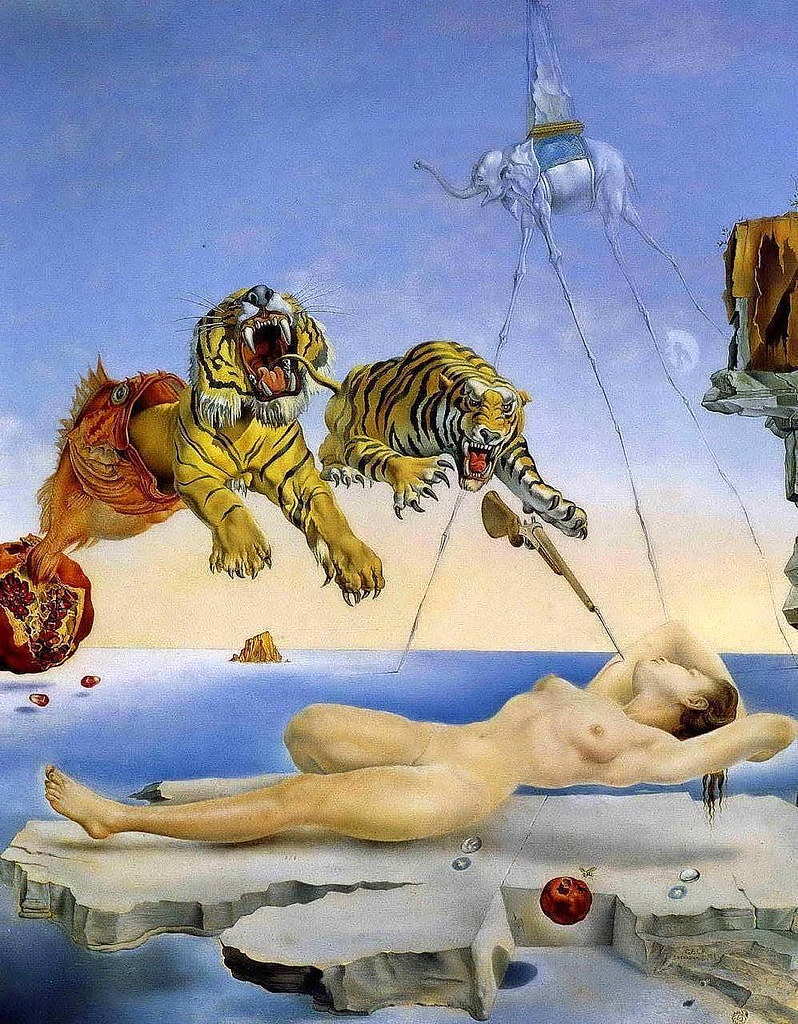
Salvador Dalí, 1965 (Photo via Wikimedia Commons, Public Domain)
Spanish Surrealist artist Salvador Dalí is among the most prolific creatives of the 20th century. He produced over 1,500 paintings over the course of his long career which spanned from 1910 until his death in 1989. Although the eccentric artist explored other mediums, including sculpture, printmaking, fashion, writing, and even filmmaking, Dalí’s paintings stand out as particularly iconic. He developed his own visual language for depicting his own inner world, dreams, and hallucinations.
“The fact that I myself, at the moment of painting, do not understand my own pictures, does not mean that these pictures have no meaning,” Dalí once said. “On the contrary, their meaning is so profound, complex, coherent, and involuntary that it escapes the more simple analysis of logical intuition.”
Read on to discover five of Dalí’s most famous paintings.
Here are five famous Salvador Dalí paintings you should know.
The Persistence of Memory, 1931
The Persistence of Memory is arguably Dalí’s most famous painting and one of the most iconic images of surrealism. It was painted in 1931 during the height of the Surrealist movement. During this time, artists were exploring their subconscious and often depicted their own dreams. When Dalí painted The Persistence of Memory, his artistic practice was guided by the strange “paranoiac-critical method.” Developed by Dalí himself, the technique involves invoking a paranoid state of mind to facilitate a work of art that captures deconstructed concepts of reality.
In The Persistence of Memory, Dalí explores the fluidity of time and space by illustrating melting watches sprawled across a Catalonian landscape. Ants surround a single pocket watch, representing decay; a concept Dalí had a fascination for. Perhaps the most perplexing part of the painting is a sleeping face-like figure on the ground. It is believed to be a self-portrait of the artist.
Dream Caused by the Flight of a Bee around a Pomegranate a Second Before Awakening, 1944
The Dream Caused by the Flight of a Bee is one of Dalí's best-known works from the post-WWII era. It depicts the sleeping figure of the artist’s wife, Gala, hovering slightly above a rock at Port Lligat, a small village located in a small bay on Cap de Creus peninsula, on the Costa Brava of the Mediterranean Sea. Beside her naked body are two drops of water, a pomegranate, and a bee which also appear to float mid-air.
Gala’s dream is prompted by the buzzing of the bee and is portrayed in the upper half of the canvas in a chain-like succession of symbols. A pomegranate bursts open to release a giant redfish from whose mouth two ferocious tigers leap together towards Gala. A rifle appears to almost pierce Gala’s arm like a bee sting, while in the middle ground, a translucent elephant carrying an ice-like obelisk on its back strides across the blue sea on spindly, stilted legs. The elephant is based on a statue by Italian artist Gian Lorenzo Bernini. For Dalí, it’s a symbol of war and destruction. Its presence conveys a mood of terror often felt in a nightmare.
The Temptation of Saint Anthony, 1946
In The Temptation of Saint Anthony, Dalí paints towering, spindly-legged animals that carry objects of temptation on their backs. The strange parade is led by a horse, representing the temptation of power. The first elephant carries the golden cup of lust and a nude woman, while the others bring buildings that represent home comforts, more nude figures, and tall towers with phallic connotations. They march towards Saint Anthony the Great, a Christian monk, during his Egyptian desert pilgrimage. He’s depicted trying to resist and warn them off with a cross. In the clouds, you can just about make out the Escorial, a Spanish royal palace.
The figure of Saint Anthony takes up very little room on the canvas; perhaps Dalí wanted to draw attention away from him, in order to better show the overpowering nature of the temptations he faced.
Galatea of the Spheres, 1952
View this post on Instagram
Galatea of the Spheres is a portrait of Dalí’s wife and muse, Gala. He depicts her head, neck, and shoulders as a series of three-dimensional spheres. The fractured image was painted during the artist’s “Nuclear Mysticism” period when he began blurring the line between figuration and abstraction. Ever since the first atomic bomb explosions of August 1945, Dalí was fascinated by nuclear physics. Once describing the atom as his “favorite food for thought,” the artist was interested in matter that was made up of atoms that did not touch each other. He replicated this idea in his art by painting individual objects suspended in peculiar formations.
Still Life – Fast Moving, 1956
In Still Life – Fast Moving, Dalí continues to explore mathematical theory by rendering it in his Nuclear Mysticism style. The artist chose to reinterpret the traditional still life painting by illustrating the objects in constant motion. Food, drinks, and tableware seem to spin around the scene in mid-air as if they’re in their own swirling vortex.
For Dalí, the spiral was nature's most perfect form, and he often used it as a symbol of cosmic order. The motif is seen throughout this painting—from the cauliflower’s structure to an iron bar on the balcony railing. While Dalí was working on this piece in 1956, scientists discovered that the DNA molecule has a spiral formation. “For the first time in the history of science,” Dali said, “physics was providing proof of the existence of God.”
Related Articles:
18 Surreal Facts About Salvador Dalí
Exploring Salvador Dalí’s Strange and Surreal ‘Persistence of Memory’
Expansive Book Features Never-Before-Seen Paintings by Salvador Dalí


























































































